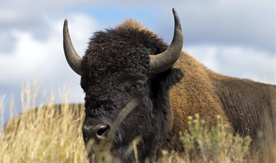 A University of Maine researcher, a doctoral student and an undergraduate are at Wind Cave National Park in Hot Springs, South Dakota excavating cave fossils that date back 11,000 years to the end of the most recent ice age.
A University of Maine researcher, a doctoral student and an undergraduate are at Wind Cave National Park in Hot Springs, South Dakota excavating cave fossils that date back 11,000 years to the end of the most recent ice age.
Scientists say preliminary samples from the material — which includes at least 22 species — will help them understand how the region, including climate, has changed.
The UMaine contingent includes Jacquelyn Gill, assistant professor of paleoecology and plant ecology; Jeff Martin, a Ph.D. student affiliated with Integrative Graduate Education and Research Traineeship (IGERT); and Chason Frost, an undergraduate.
The UMaine trio has partnered with the Mammoth Site of Hot Springs for the project centered around a cave that is 27 feet long and less than two feet high.
“What’s really cool about the cave is that it includes these animals that are both extinct and animals that are survivors of the Ice Age,” Gill told the Rapid City Journal as she sifted through fossilized teeth, vertebrae and rib bones the size of fingernail clippings.
“When you can put all these different pieces of ecosystem together it basically gives you a sense of how an environment changes as the climate changes.”
Gill is working with plant fossils and Martin is interested in bison fossils.
Marc Ohms, a physical science technician at the park, discovered Persistence Cave, as it has been dubbed, in spring 2004; its presence was kept a secret until now so amateur explorers wouldn’t damage the material inside.
Jim Mead of East Tennessee State University is head of the crew that also will screen-wash the material and prepare it for curation.
The UMaine contingent will take part in live-tweeting sessions (twitter.com/hashtag/cavebison), in partnership with UMaine’s Follow a Researcher, at 1 p.m. EST Tuesday, June 16, and Thursday, June 18. The expedition hashtag is #cavebison.
In addition, Martin is blogging about the experience at bisonjeff.weebly.com/bisonlarge-blog.
